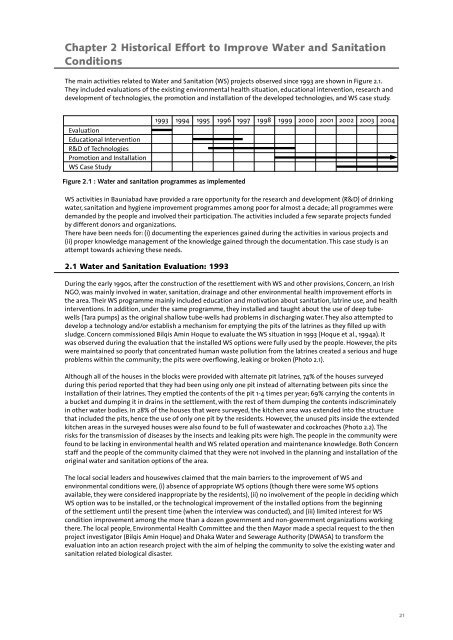Untitled - UNU-IAS - United Nations University
Untitled - UNU-IAS - United Nations University
Untitled - UNU-IAS - United Nations University
You also want an ePaper? Increase the reach of your titles
YUMPU automatically turns print PDFs into web optimized ePapers that Google loves.
Chapter 2 Historical Effort to Improve Water and Sanitation<br />
Conditions<br />
The main activities related to Water and Sanitation (WS) projects observed since 1993 are shown in Figure 2.1.<br />
They included evaluations of the existing environmental health situation, educational intervention, research and<br />
development of technologies, the promotion and installation of the developed technologies, and WS case study.<br />
<br />
<br />
<br />
<br />
<br />
<br />
<br />
<br />
WS activities in Bauniabad have provided a rare opportunity for the research and development (R&D) of drinking<br />
water, sanitation and hygiene improvement programmes among poor for almost a decade; all programmes were<br />
demanded by the people and involved their participation. The activities included a few separate projects funded<br />
by different donors and organizations.<br />
There have been needs for: (i) documenting the experiences gained during the activities in various projects and<br />
(ii) proper knowledge management of the knowledge gained through the documentation. This case study is an<br />
attempt towards achieving these needs.<br />
<br />
<br />
2.1 Water and Sanitation Evaluation: 1993<br />
During the early 1990s, after the construction of the resettlement with WS and other provisions, Concern, an Irish<br />
NGO, was mainly involved in water, sanitation, drainage and other environmental health improvement efforts in<br />
the area. Their WS programme mainly included education and motivation about sanitation, latrine use, and health<br />
interventions. In addition, under the same programme, they installed and taught about the use of deep tubewells<br />
(Tara pumps) as the original shallow tube-wells had problems in discharging water. They also attempted to<br />
develop a technology and/or establish a mechanism for emptying the pits of the latrines as they filled up with<br />
sludge. Concern commissioned Bilqis Amin Hoque to evaluate the WS situation in 1993 (Hoque et al., 1994a). It<br />
was observed during the evaluation that the installed WS options were fully used by the people. However, the pits<br />
were maintained so poorly that concentrated human waste pollution from the latrines created a serious and huge<br />
problems within the community; the pits were overflowing, leaking or broken (Photo 2.1).<br />
Although all of the houses in the blocks were provided with alternate pit latrines, 74% of the houses surveyed<br />
during this period reported that they had been using only one pit instead of alternating between pits since the<br />
installation of their latrines. They emptied the contents of the pit 1-4 times per year; 69% carrying the contents in<br />
a bucket and dumping it in drains in the settlement, with the rest of them dumping the contents indiscriminately<br />
in other water bodies. In 28% of the houses that were surveyed, the kitchen area was extended into the structure<br />
that included the pits, hence the use of only one pit by the residents. However, the unused pits inside the extended<br />
kitchen areas in the surveyed houses were also found to be full of wastewater and cockroaches (Photo 2.2). The<br />
risks for the transmission of diseases by the insects and leaking pits were high. The people in the community were<br />
found to be lacking in environmental health and WS related operation and maintenance knowledge. Both Concern<br />
staff and the people of the community claimed that they were not involved in the planning and installation of the<br />
original water and sanitation options of the area.<br />
The local social leaders and housewives claimed that the main barriers to the improvement of WS and<br />
environmental conditions were, (i) absence of appropriate WS options (though there were some WS options<br />
available, they were considered inappropriate by the residents), (ii) no involvement of the people in deciding which<br />
WS option was to be installed, or the technological improvement of the installed options from the beginning<br />
of the settlement until the present time (when the interview was conducted), and (iii) limited interest for WS<br />
condition improvement among the more than a dozen government and non-government organizations working<br />
there. The local people, Environmental Health Committee and the then Mayor made a special request to the then<br />
project investigator (Bilqis Amin Hoque) and Dhaka Water and Sewerage Authority (DWASA) to transform the<br />
evaluation into an action research project with the aim of helping the community to solve the existing water and<br />
sanitation related biological disaster.<br />
21
















